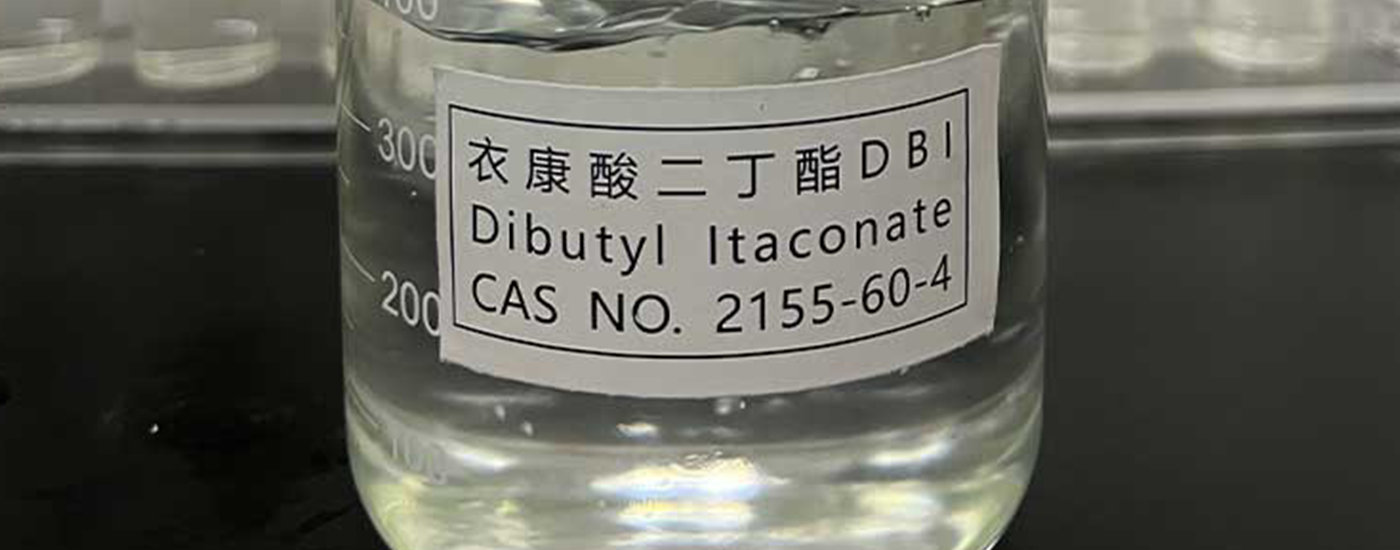
Performance characteristics
Reactivity: The molecular structure of dibutyl itaconate contains an ester group. It is produced by esterification of itaconic acid (an unsaturated dicarboxylic acid) and butanol. The carbon-carbon double bond in its chemical structure gives it a certain reactivity, and it can participate in a variety of chemical reactions, such as addition reactions.
Physical properties
Solubility: It has good solubility and can be dissolved in a variety of organic solvents, such as ethanol, ether, acetone, etc. This good solubility enables it to play a good role in some reactions or applications that need to be carried out in an organic solvent system.
Boiling point and volatility: It has a relatively moderate boiling point, which allows it to remain relatively stable under certain temperature conditions and will not volatilize too quickly. This feature is more important in some scenarios where it needs to be used during heating, such as in some thermal curing systems, it will not affect the composition and performance of the system due to excessive volatilization.
Good stability: At room temperature and pressure, dibutyl itaconate is relatively stable. However, in the presence of an initiator or under conditions such as light and high temperature, the carbon-carbon double bonds in its molecules can undergo polymerization to form high molecular polymers. The characteristics of this polymerization reaction make it have important applications in the field of polymer synthesis.
Low toxicity: Dibutyl itaconate is a low-toxic substance, which makes its use in some application fields with high safety requirements, such as food packaging, medical devices, etc. subject to certain restrictions, but in most industrial and civilian fields, its low toxicity allows it to be used relatively safely.
Application field
Polymer material field: Dibutyl itaconate can be used as a comonomer for synthetic rubber. In the synthesis process of styrene-butadiene rubber, nitrile rubber, etc., the addition of dibutyl itaconate can improve the flexibility, aging resistance and wear resistance of rubber. For example, after the introduction of dibutyl itaconate units into styrene-butadiene rubber, the flexibility of the rubber molecular chain increases, making it less likely for rubber products to crack during use, and extending the service life of rubber products. It can be used to prepare unsaturated polyester resin. Unsaturated polyester resin is a thermosetting resin. The double bonds of dibutyl itaconate participate in the cross-linking reaction of polyester, which can improve the hardness, toughness and chemical corrosion resistance of the resin. When manufacturing FRP products (such as boat hulls, automobile parts shells, etc.), using unsaturated polyester resins containing dibutyl itaconate can make the products have better mechanical properties and weather resistance.
Coatings: As an additive for coatings, dibutyl itaconate can improve the flexibility, adhesion and drying speed of coatings. In some solvent-based coatings, it helps the coating to adhere better to different substrates, and can make the coating have a certain elasticity after drying and not easy to crack. For example, in wood coatings, adding dibutyl itaconate can make the coating better adapt to the expansion and contraction changes of wood in different humidity environments and maintain the integrity of the coating.
Adhesives: In adhesive formulations, dibutyl itaconate can adjust the viscosity and curing speed of adhesives. It can make adhesives have better bonding strength and adaptability when bonding different materials, such as plastics and metals, wood and leather, etc.
Other fields Plasticizer field: Dibutyl itaconate can be used as a plasticizer. It can be inserted between polymer molecular chains, increase the distance between molecular chains, and reduce the glass transition temperature of polymers, thereby making polymer materials softer. In the processing of plastics such as polyvinyl chloride (PVC), it can replace some traditional plasticizers to provide better durability and low temperature performance.
Application
Copolymerization application: In polymer synthesis, dibutyl itaconate is usually added to the reactor together with other monomers in the polymerization reaction system. For example, when synthesizing unsaturated polyester resin, dibutyl itaconate and monomers such as maleic anhydride and ethylene glycol are added to a reactor with a stirring device and a heating device according to a certain molar ratio. Parameters such as temperature, stirring speed and reaction time need to be controlled during the reaction. The general reaction temperature is about 150-200℃, and the stirring speed must ensure that the monomers can be fully mixed and evenly mixed. The reaction time may vary from several hours to more than ten hours depending on the specific formula and requirements.
Additive application: When dibutyl itaconate is used as an additive for coatings or adhesives, it is usually added in the later stage of the preparation of coatings or adhesives. After the main film-forming substances (such as resins), solvents, pigments, etc. are mixed evenly, dibutyl itaconate is slowly added under appropriate stirring conditions. The amount of addition is generally determined according to the specific product performance requirements. In coatings, the amount of addition may account for about 1% – 10% of the total mass of the coating, and in adhesives, it may account for about 0.5% -5% of the total mass of the adhesive. After addition, it is necessary to continue stirring for a period of time to ensure that dibutyl itaconate is evenly dispersed in the system. In plastic processing, dibutyl itaconate is added as a plasticizer when mixing plastic raw materials (such as PVC resin powder) and other additives (such as stabilizers, lubricants, etc.). They are fully mixed and evenly mixed by a high-speed mixer, and then plasticized in processing equipment such as a twin-screw extruder. In this process, dibutyl itaconate molecules will gradually penetrate between the PVC molecular chains and play a plasticizing role.

